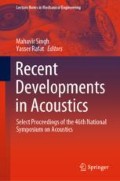Abstract
The Atmospheric Boundary Layer (ABL) was continuously monitored using Monostatic SODAR, which was conducted at CSIR-NPL, New Delhi. In this paper, an effort has been made to review the studies in the field of the structure of ABL using SODAR echograms in Delhi during a special observation period of the experiment. The change in weather conditions has found to have definite marks on the SODAR observed the structure of ABL. In particular, it has been seen that dot echoes and spiky top layered structures are different typical structures of the different seasons, which are associated with temperature, wind speed, and relative humidity. Also, the knowledge of these structures is great to use in air pollutant studies and dispersion models.
Access this chapter
Tax calculation will be finalised at checkout
Purchases are for personal use only
References
Singal SP, Gera BS (1982) Acoustic remote sensing of the boundary layer. Sadhana 5(2):131–157
Singal SP (ed) (2006) Acoustic remote sensing applications, vol 69. Springer
Bradley S (2007) Atmospheric acoustic remote sensing: principles and applications. CRC Press
Kumar N, Soni K, Garg N, Agarwal R, Singh DSM, Singh G (2017) SODAR pattern classification and its dependence on meteorological parameters over a semiarid region of India. Int J Remote Sens 38:3466–3482
Danilov SD, Gur’yanov AE, Kallistratova MA, Petenko IV, Singal SP, Pahwa DR, Gera BS (1992) Acoustic calibration of sodars. Meas Sci Technol 3(10):1001
Chandara ND, Pal S, Chandra Patranabis C, Dutta HN (2010) A neurocomputing model for SODAR structure classification. Int J Remote Sens 31(11):2995–3018
Author information
Authors and Affiliations
Corresponding author
Editor information
Editors and Affiliations
Rights and permissions
Copyright information
© 2021 Springer Nature Singapore Pte Ltd.
About this paper
Cite this paper
Kumar, N., Soni, K., Agarwal, R., Singh, M. (2021). Studies Different Structure of Atmospheric Boundary Layer Using Monostatic SODAR. In: Singh, M., Rafat, Y. (eds) Recent Developments in Acoustics. Lecture Notes in Mechanical Engineering. Springer, Singapore. https://doi.org/10.1007/978-981-15-5776-7_27
Download citation
DOI: https://doi.org/10.1007/978-981-15-5776-7_27
Published:
Publisher Name: Springer, Singapore
Print ISBN: 978-981-15-5775-0
Online ISBN: 978-981-15-5776-7
eBook Packages: EngineeringEngineering (R0)

